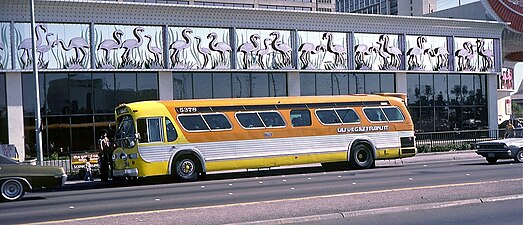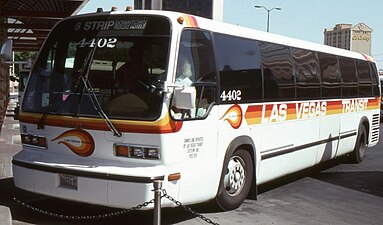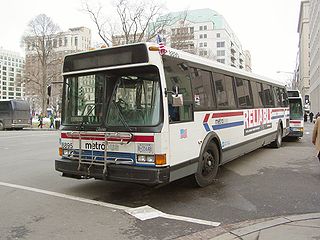History
Overview
The Vegas Transit Company (VTC) started public transportation operations in Las Vegas on August 20, 1942 with three routes and six buses by 1943. The Tanner family (as Tanner Motor Tours of Nevada) acquired VTC, then sold the franchise in 1965 to Henry Burroughs, who rebranded it as the Las Vegas Transit System (LVTS). [1] : 226 Both LVTS and Gray Line Tours of Southern Nevada (GLT) were owned by First Gray Line West of Los Angeles, California. LVTS and GLT operated out of the same yard, on Industrial Rd near Charleston Blvd. [2] Due to its lucrative Strip route, LVTS made significant profits for its owners.
LVTS operated between 1965 and approximately 1993. They were bought out by the Regional Transportation Commission of Southern Nevada (RTCSNV) in early 1993 for $900,000. RTCSNV inaugurated its Citizens Area Transit service in December 1992, and for a time, there were technically two public transit systems in Las Vegas until LVTS faded away. After CAT took over, LVTS only competed with CAT on the busy and lucrative Route #6 "Strip" for several months before being bought out. The CAT system is now known as RTC Transit.
1960s–1970s
LVTS ran a frequent and efficient service for many years during the 1960s and 1970s when the city was small; their routes covered most of the city. At the time, they were considered a vast improvement over its predecessor, Vegas Transit Lines. In 1972, approximately 8,000 passenger trips were operated per weekday. [3] In an article written in Bus World Magazine in 1978, they were praised as a self-sufficient bus system. However, LVTS suspended service to West Las Vegas, a predominantly black neighborhood, in 1969 after a series of racial violence incidents; the NAACP sued LVTS in 1974 stating the service was racially discriminatory. [1] : 226 At the time, government officials also began exploring the idea of starting a public transit system to take advantage of federal subsidies. [1] : 227
| No. | Name | Headway (min) | Runs/ day | Buses required |
|---|---|---|---|---|
| 1 | Hyde Park | 60 | 14 | 1 |
| 3 [lower-alpha 4] [lower-alpha 5] | Salt Lake Hwy | 30 | 27 | 4 |
| 4 [lower-alpha 4] [lower-alpha 5] | Boulder Hwy | 30 | 27 | 4 |
| 5 | Huntridge | 60 | 14 | 1 |
| 6 [lower-alpha 4] [lower-alpha 5] | Strip | 15 | 78 | 6-10 |
| 7 | College Park | 45 | 20 | 1 |
| 8 | Golfridge | 60 | 14 | 1 |
| 9 | Vegas Heights | 30 | 20 | 2 |
| 10 | University | 60 | 13 | 1 |
| Notes | ||||
In September 1974, LVTS experimented with a "grid" route system to expand coverage, replacing the former "hub and spoke" system at the insistence of the Regional Transit Commission. The new system expanded coverage to 75,000 additional riders, but the expected increase in ridership never materialized, and LVTS petitioned to return to the "hub and spoke" in January 1975. [3] They then went back to the old hub and spoke route system and enjoyed an increase in ridership, as detailed in the 1978 magazine article.

As in later decades, the #6 Strip route provided the money for the other money-losing residential routes and allowed the small private transit company to turn a profit. Being a successful private bus company is an exceptional feat, as by the 1960s, virtually all transit systems in the US had been taken over by municipal governments and heavily subsidized by taxpayer dollars due to declining riderships. By 1975, LVTS was operating at breakeven or a deficit, and any expansion would have to come via public subsidy. [3]
In 1978, LVTS operated a fleet of 26 buses, with half of them less than 5 years old. During 1976–1977, ridership rose by 21.8%. However, by 1979, an external consultant concluded the system was one of the worst in the nation, and that at least 110 buses would be required to provide adequate service. [1] : 226
1980s–1990s
In the early 1980s, the routes were all finally synchronized to arrive/depart at the downtown transfer center at the same time to facilitate passenger transfer, except for the more-frequently running Route #6. In order to hold fares steady, a public/private partnership was set up in 1980 where the Regional Transportation Commission of Southern Nevada would apply for federal funds for buses, and approximately 1⁄4 of the local matching funds would be provided by LVTS, with the remainder provided by RTC. In turn, RTC would lease the buses to LVTS at no cost. The first RTC-purchased buses arrived in September 1981. [4]
By the 1980s and early 1990s, the private bus system was no longer adequate and lacked both the service frequency and route coverage to accommodate the explosive growth of the Las Vegas Valley. In 1981, the State Futures Commission said that mass transit was the key issue in Clark County; a 1983 ballot proposal to fund an expansion of the system by raising sales taxes was voted down resoundingly, though. [1] : 227 According to Las Vegas Review-Journal articles at the time, LVTS claimed that government subsidies were needed to expand the coverage area and increase frequency of service. They contended the existing coverage with limited residential routes was dictated by the more lucrative Route #6 "Strip", which generated enough profit to support the current system. Even with population growth exceeding 60% between 1970 and 1980, the average residential density remained under 5 people in 1 acre (0.40 ha); the bus system in Las Vegas had also acquired a reputation for serving those who could not drive: the destitute and elderly, meaning there was little incentive to expand the system into areas that would not ride the bus under any circumstances. 60% of LVTS riders were tourists, nearly all riding #6 "Strip". [5] The small coverage area made it extremely difficult for people to use the buses, and ridership was limited to those who had no means of private transportation.
In addition, even though Route #6 "Strip" was the busiest and its buses were packed with tourists, that route was operated with the oldest equipment, including the smallest 35 ft long × 96 in wide fishbowls. The air conditioning units on these older buses were frequently out of service. By contrast, some of the residential routes, with few passengers, were operated with the newest buses, which were city-owned, 40 ft long × 102 in wide, Grumman 870s and Gillig Phantoms. One reason for this was the city mandated that these newer city-owned buses, which also had handicap accessibility, run on the residential areas.[ citation needed ]
| No. | Name | Headway (min) | Runs/ day | Days/ wk | Buses required |
|---|---|---|---|---|---|
| 1 | Hyde Park | 60 | 13 | 7 | 1 |
| 2 | North Las Vegas | 60 | 10-19 | 6 [lower-alpha 3] | 1 |
| 3 [lower-alpha 4] | Salt Lake Hwy | 30 [lower-alpha 5] | 7 | 2 [lower-alpha 5] | |
| 60 | 1 | ||||
| 4 [lower-alpha 4] | Boulder Hwy | 60 | 13+1⁄2 | 7 | 1 |
| 5 | Huntridge | 60 | 13 | 7 | 1 |
| 6 [lower-alpha 6] [lower-alpha 4] | Strip | ≤15 | 7 | ||
| 6A [lower-alpha 7] | Sam's Town/ Strip | 60 | 6 [lower-alpha 3] | 1 | |
| 7 | College Park | 60 | 13 | 7 | 1 |
| 8 | Golfridge | 60 | 13 | 7 | 1 |
| 9 | Vegas Heights | 60 | 13 | 7 | 1 |
| 10 | University | 30 [lower-alpha 5] | 18+1⁄2 | 7 | 2 [lower-alpha 5] |
| 11 [lower-alpha 7] | Henderson | 60 | 10 | 6 [lower-alpha 3] | 1 |
| 12 [lower-alpha 7] | Spring Valley | 60 | 11+3⁄4 | 6 [lower-alpha 3] | 1 |
| 13 [lower-alpha 7] | Strip Shuttle | 20 | 7 | [lower-alpha 8] | |
| 14 [lower-alpha 7] | Mall Hopper | 6 [lower-alpha 3] | 2 | ||
| – | Strip Express [lower-alpha 9] | [lower-alpha 10] | |||
Notes
| |||||
A limited expansion of coverage followed the late 1970s and early 1980s, but it was too little and too late. In fact, LVTS were voted as the worst transit system in the country during one year in the 1980s The city had outgrown the small private transit system; it was unrealistic for the city to expect a private bus company, without a taxpayer subsidy, to expand and run throughout the city based solely on its Strip revenue. LVTS were providing a public service, but they also needed to turn a profit to continue.
In 1990, the Las Vegas City Council rescinded the 48-year-old private franchise agreement in order to exert more control over public transportation services. That year, voters passed Question 10, which advised the state legislature to issue $100 million per year to fund mass transit in addition to a host of other transportation improvements, marking the start of what would become Citizens Area Transit. [1] : 228–229 LVTS's general manager, Barry Perea, fought to keep LVTS in business and was strongly opposed to the formation of CAT, orchestrated by RTC chairman Bruce Woodbury after Clark County voters approved a quarter-cent sales tax increase in 1990 to fund a public transit system.
When Citizens Area Transit (CAT) started operating in November 1992, LVTS turned over all residential routes but clung onto the Route #6 "Strip" operation. The newer city-owned buses (Grumman 870s, GMC RTSs, and Gillig Phantoms) were returned and given to CAT. LVTS competed head to head with CAT on the Strip using their older buses from November 1992 until about April or May 1993, when they were bought out by the RTC for $900,000. The cash fare was $1.25 for a LVTS ride and $1 for a CAT ride at the time, indicating an effort by CAT to undercut Las Vegas Transit and speed its demise. What service remained, along with a few buses, was taken over by the affiliated Las Vegas Gray Line, which continued operating for decades afterward. Eventually taken over by Coach USA and renamed Transportation Unlimited, operation of the route finally ended in 2004, being conducted with six ex-Stockton CA RTSs at the end.




































